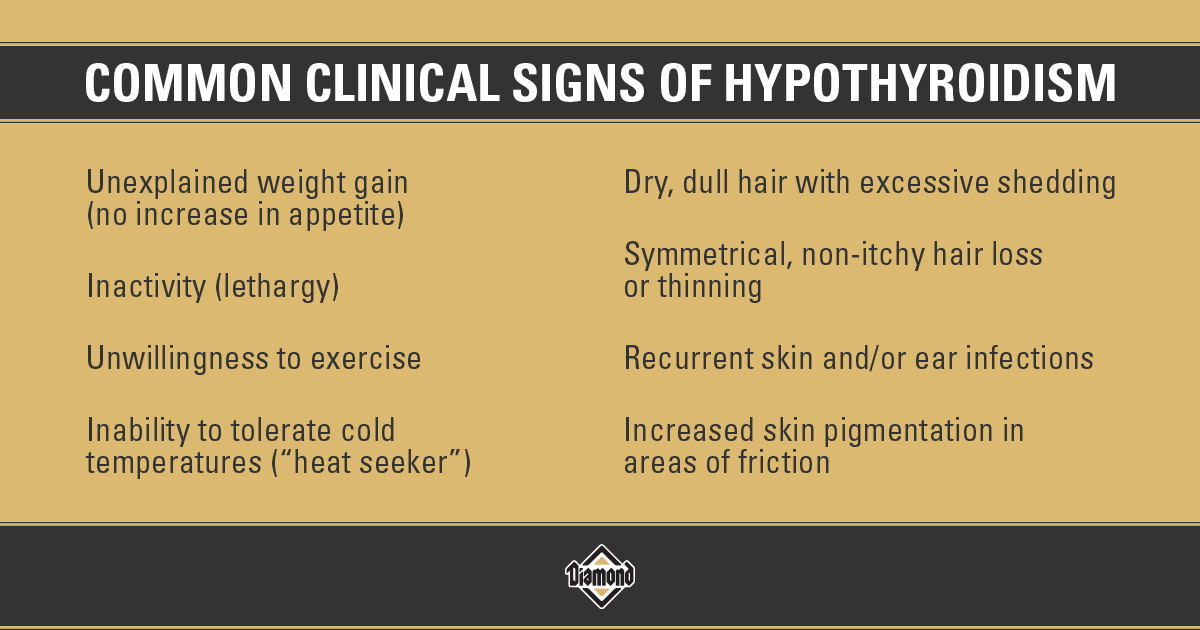Hypothyroidism, also referred to as underactive thyroid disease, affects about 1 in every 100 dogs, making it the most common hormone imbalance, or endocrine disease, in dogs.
Since the condition is typically seen in middle-aged, medium- and large-breed dogs, you should know more about hypothyroidism, its clinical signs and symptoms, and its treatment if your canine companion is approaching middle age.
What is the thyroid gland?
The thyroid gland is a small, butterfly-shaped gland with two lobes, one on each side of the trachea, or windpipe, in the neck. One of the most important glands in the body, the thyroid produces iodine-containing hormones that regulate your dog’s metabolism — the rate at which energy is produced from nutrients and oxygen — or the speed at which body processes “run.”
Thyroxine (T4) and triiodothyronine (T3) are two important hormones secreted by the thyroid gland. T4 is the biologically active thyroid hormone, the one that produces effects on every cell, tissue and organ in the body.
In addition to metabolism, thyroid hormones regulate cholesterol, fat metabolism and red blood cell production. They are also necessary for nervous system development. Finally, T4 is needed by growing muscles and maintaining the ability of muscles to contract.
What is hypothyroidism?
Hypothyroidism occurs when the thyroid gland fails to make and secrete enough T3 and T4. More than 95 percent of canine hypothyroidism cases result from gradual destruction of the thyroid gland. The damage is frequently attributed to inflammation resulting from the immune system attacking the gland. Genetics play a role in this type of hypothyroidism. Shrinkage of the thyroid gland can also have an unknown cause. In these cases, normal gland tissue is replaced by fat.
Regardless of the underlying cause, thyroid gland destruction leads to too little hormone production and hypothyroidism.
Which dogs are most likely to develop hypothyroidism?
Hypothyroidism can occur in any dog breed, although it is most common in medium- to large-breed dogs. Thyroid disease rarely occurs in toy and miniature breeds. According to the Merck Veterinary Manual, the breeds most commonly affected include golden retriever, Doberman pinscher, Irish setter, miniature schnauzer, dachshund, cocker spaniel and Airedale terrier.
The condition is most common in 4- to 10-year-old dogs, with an average age at diagnosis of 7 years.
Hypothyroidism occurs equally in both male and female dogs (unlike humans), although spayed females may be at greater risk than intact dogs.
What are the signs and symptoms of hypothyroidism?
Because thyroid hormones regulate the body’s metabolism, insufficient amounts of hormones slow your dog’s metabolism. And when metabolism slows, virtually every organ system is affected. In addition, because thyroid gland damage is gradual, most of the metabolism-related signs of hypothyroidism develop slowly and may be easy to miss at first.
One of the most common signs of hypothyroidism in dogs is skin disease, and skin disease is the most common reason for seeking veterinary care. The classic presentation is non-itchy hair thinning or loss that has the same pattern on both sides of a dog’s trunk. The coat may be dry, with excessive shedding. The skin may be dry and flakey for some dogs, while others may have oily, smelly and scaly skin. In addition, skin may become darker over areas of wear or friction, such as the armpits and groin. Dogs with hypothyroidism may experience recurring skin and ear infections.
Because thyroid hormones affect virtually every cell, it’s not surprising that dogs with hypothyroidism show signs in several body systems. While signs associated with skin conditions and decreased metabolism are more common, other less frequently seen signs and symptoms include infertility in both male and female dogs, abnormal nerve function, thickening of facial skin and fat deposits in the corneas of the eyes.

How is hypothyroidism diagnosed?
Your veterinarian will use information about your dog such as age and breed, the history of clinical signs and symptoms that you provide, and findings from a physical exam and laboratory tests to make a diagnosis.
The most common screening blood test used in veterinary medicine is the total thyroxine (TT4) level. This test measures the main thyroid hormone in a blood sample. A low TT4 level combined with the presence of clinical signs is suggests your dog is potentially hypothyroid. A definitive diagnosis is made by having the laboratory run two additional tests to evaluate concentrations of free T4 (fT4) and thyroid-stimulating hormone (TSH). If the TT4 and fT4 levels are low and the TSH level is high, your dog has hypothyroidism.
How is hypothyroidism in dogs treated?
Hypothyroidism in dogs is not preventable or curable, but it’s definitely treatable. In fact, dogs diagnosed with hypothyroidism that are treated and monitored can have an excellent quality of life.
Treatment of hypothyroidism involves increasing or replacing the missing thyroid hormone, which is typically thyroxine. The drug of choice for treating canine hypothyroidism is levothyroxine, an oral synthetic thyroid hormone, which must be given for the rest of the dog’s life. The dog will get an additional blood test to ensure they are receiving an appropriate dose and then be tested once or twice a year to determine if the dosage needs to be adjusted.
Improvements in clinical signs may be seen four to six weeks after starting treatment. You may notice a change in your dog’s activity level within one week. Skin- and coat-related signs may take several months to resolve.
If you wonder if your dog could be experiencing hypothyroidism, talk with your veterinarian. Because the thyroid gland is so important to normal body functioning, you’ll want to know if your dog has hypothyroidism and, if so, that it’s properly controlled. For more detailed information about hypothyroidism in dogs, check out this article at Veterinary Partner.







